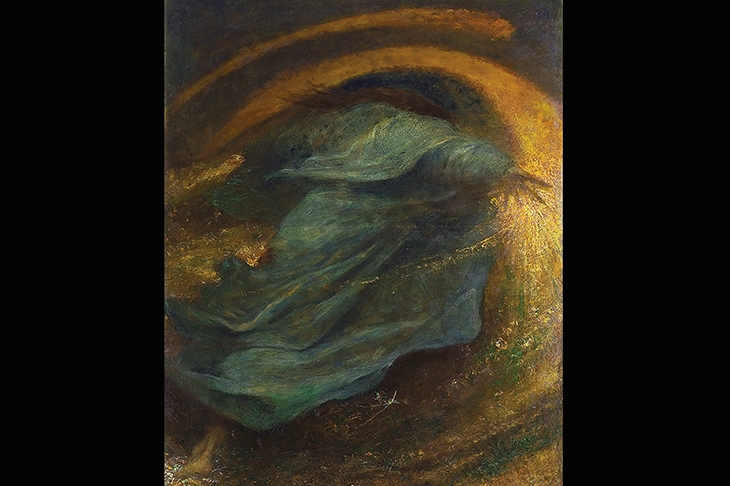On his deathbed in 1904, George Frederic Watts saw a extraordinary spectacle. He witnessed the universe coming into being: the ‘breath of the Creator acting on nebulous matter’ causing ‘agitating waves & revolving lines’ to fly out in all directions. With hindsight, it is tempting to conclude that Watts had a vision not, as he thought, of reality in ‘a glorious state’, but of abstract painting.
The beautifully installed exhibition at the Watts Gallery, Compton, Surrey, celebrating the bicentenary of his birth actually contains a few pictures that — surprisingly for a great Victorian — put one in mind of Jackson Pollock. The trouble is that much of Watts’s work is also abstract in another sense: it attempts to depict intangible concepts — abstract nouns such as Time, Death and Judgment — in the form of muscular nudes and shrouded figures.
Many such pictures have a comic side. ‘Love and Life’ (1884) looks like a couple of teenagers having second thoughts about mountaineering in the altogether (the figure representing ‘Life’ seems to be a fond memory of his first wife, the actress Ellen Terry, without her clothes). But there is something noble as well as ridiculous about Watts’s attempts to paint the unpaintable.
He was unclassifiable as a artist and also an odd man. Nicholas Tromans, curator of the Watts Gallery, compares him to William Blake: two Cockney visionaries, not to say eccentrics, both of whom emulated the art of Renaissance Italy in a thoroughly idiosyncratic way. Watts, the son of a piano tuner, was dubbed ‘England’s Michelangelo’, although his mural in the Great Hall of Lincoln’s Inn is a direct imitation of Raphael’s ‘School of Athens’, substituting notable lawyers for classical philosophers.
One difference from Blake is that Watts, though reclusive, was more socially accept-able; at one point he was taken up by the proto-Bloomsburies of the Holland House set. Another is that Blake’s works were small or miniature in scale, whereas Watts tended to giganticism. One of his earlier efforts, ‘A Story from Boccaccio’ (1844-7, unfortunately not in the exhibition) depicted a woman being eaten by dogs in front of an audience of medieval Florentines on a canvas the size of a London bus.
There are some pretty stonking paintings on display, nonetheless. Watts’s trio of pictures on the theme of femininity includes colossal, though soft-focus, nudes on canvases eight feet high. ‘Eve Tempted’ and ‘Eve Repentant’ flank the central panel; ‘She Shall Be Called Woman’ (1875–92) presents a blurry but voluptuous body amid a sort of nuclear explosion of flowers, cloud and hair. This triptych annoyed Burne-Jones, who complained about Watts’s ‘3 whacking Eves I can’t abide’.
The aspects of these strange works that upset his contemporaries — the sensuality and freedom of brushwork — now seem like their redeeming features. Watts painted with a great deal more gusto than the mimsy Burne-Jones. But he also tended to be at his best when at his most nebulous.
Or, alternatively, most concrete: because Watts could be one of the best of Victorian portrait painters. The emaciated, burning-eyed, fanatically austere image of Cardinal Manning (1882) is an out-and-out masterpiece. So too is the allegorical portrait of his first, teenage bride, Ellen Terry — she was 16, he was 46. This wonderful though troubling picture, entitled ‘Choosing’ (1864), shows her sensibly going for earthly vanities, symbolised by sinfully red camellias, over more virtuous violets. The marriage lasted only a year.
The older he got, the more vague Watts’s subjects tended to become. ‘The Sower of Systems’ (1902) is very close to being a picture of pure energy, consisting of scything blue brushstrokes and coruscating yellow ones with just enough hints — a gesturing hand, a vigorously planted foot — to indicate that you are looking at a figure clad in a robe, striding through a force field which recalls his later, deathbed vision.
Here is Watts’s visualisation of the universe in a state of permanent creation, as — according to Mary, the second Mrs Watts — stars, planets and suns are scattered from the figure’s hands like seeds. The artist apparently got the idea from looking at the ‘curiously refracted rays’ thrown by a night-light on his bedroom ceiling.
At moments like this Watts seems positively avant-garde. ‘After the Deluge’ (c. 1885–91) is a radiant mass of light above the sea which brings to mind the burning suns that Vincent van Gogh was painting in Provence at the very same time — except that the Watts is a step further away from visual reality, and closer to Rothko.






Comments